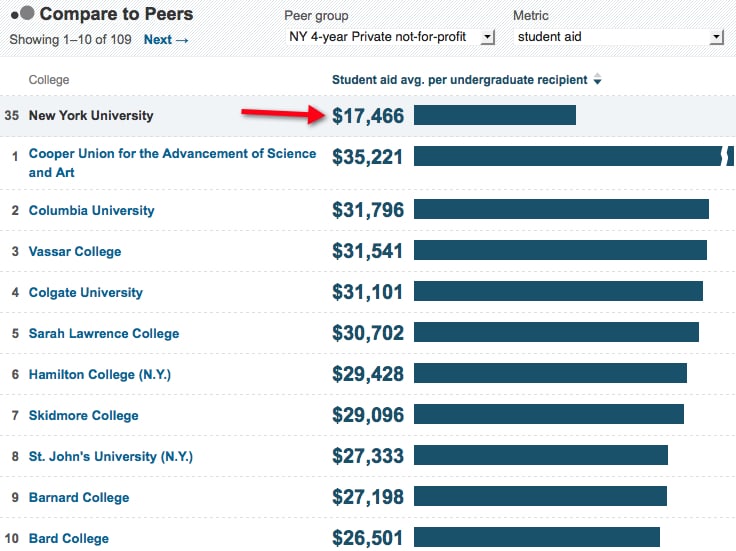I’m always excited when I run across a new resource to help families research colleges. Today I’m happy to share a valuable one from The Chronicle of Higher Education.
College Completion is a microsite within the website of the higher-ed trade publication. I mentioned the tool briefly in this recent college blog post: 12 Ways to Find and Research Colleges.
Today I want to spend more time sharing ways to use the site, which contains graduation statistics and other data for 3,800 institutions.
When you arrive on the College Completion site, here is what you’ll see:
Every one of colored boxes on the home page represents a school with the larger boxes representing the institutions graduating the most students who began college in 2004. Among public universities, the University of Illinois Champaign-Urbana graduated the most students (6,094). New York University is the private school with the most graduates (3,821) while Valencia Community College produced the most grads (1,020) in its category.
What you will find valuable is the data provided for each school in the database. To find a school, type its name into the search box in the upper left hand corner of the home page.
University of Illinois
Here is part of what I retrieved for the University of Illinois:
What’s Important
The University of Illinois has a four-year grad rate (67.4%) which is superior to nearly all other public universities. As you can see from the chart, the four-year grad rate at the average state school is just 31.3%. Public universities that have a better grad rate include the University of North Carolina, University of Virginia, College of William and Mary, University of Michigan, UCLA and the University of California, Berkeley.
Illini’s six-year grad rate (84.4%) is also much higher than the national average (56%) for state schools. What I also find helpful are the grad rates broken down by types of students. The four-year grad rates for minority students at Illini is superior to the national average, which is also impressive.
College Stats in Context
College Completion allows you to compare a school’s stats in even more ways. Check out how Illinois compares to the national average in a variety of categories:
According to the above chart, Illinois is in the 97% percentile for graduation, median SAT score and student aid. The flagship is, however, quite low in the percentage of Pell Grant (low-income) students that it educates.
New York University
What I also find handy on this site is that you can compare a school with peer institutions based on such factors as grad rates and student aid. Here is a comparison of NYU’s average student aid with other institutions in New York:
NYU deservedly has a reputation for dispensing lousy financial aid packages. The chart clearly illustrates that NYU lags far behind some other well-regarded private institutions in New York state.
On College Completion, you can also form your own custom peer group when comparing stats for an individual school. After you click the custom peer link, you can add any colleges and universities that you like.
Explore
There is much more to discover on College Completion, including the ability to research schools by state, but this should get you started. The more research families do when exploring colleges, the better  the odds that their teenagers will end their college searches successfully.
the odds that their teenagers will end their college searches successfully.
Lynn O’Shaughnessy is the author of The College Solution: A Guide for Everyone Looking for the Right School at the Right Price.





Once again, Lynn- Awesome! Thanks so much!
Lynn,
Thank you for sharing this great resource. To follow up on Mike’s comment, the 4-year graduation data are misleading for schools like Drexel and Cincinnati that have co-op programs in which students can deliberately choose a 5-year bachelor’s degree option.
Julie
Lynn,
Is there a way to figure out WHY a graduation rate is low? I’ll give you a specific example, New Mexico Tech. On paper they look like they offer many appealing things. The are small, have a good student to faculty ratio, produce a lot of students that ultimately get PhDs and are one of the least expensive schools out there, especially if you’re in state or qualify for WUE. The kicker is that their graduation rate is very poor. Any suggestions on how to sleuth that out without just making assumptions?
Mike
Hi Mike,
One thing you can look at is the freshmen retention rate. The grad rate is going to be much lower if a significant number of freshman leave after one year. The federal rate only counts full-time students who remain at their original school. This leads to misleading figures.
Lynn O’Shaughnessy
The name of this premier research university is University of Illinois at Urbana-Champaign, a town name with an (ultimately) Latin derivative for “country/countryside” and not at all for French fizzy wine
Thanks Linda. I had changed the name originally before I finished my post, but my edit didn’t go through when my computer froze. I studpidly didn’t go back and see if the change was made. Thanks for alerting me. I knew better!
Lynn O’Shaughnessy